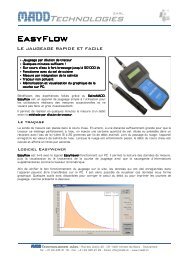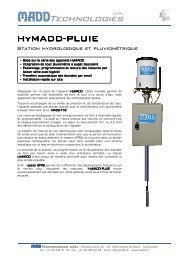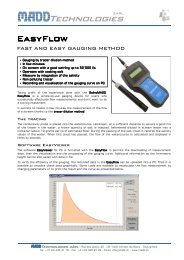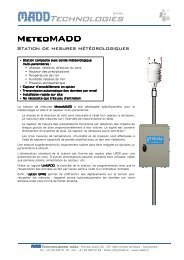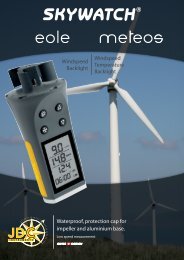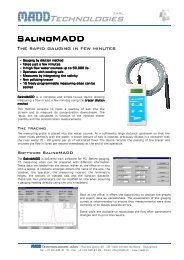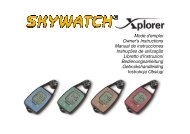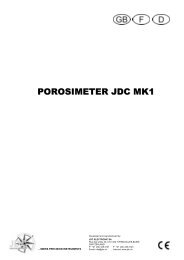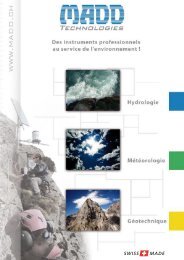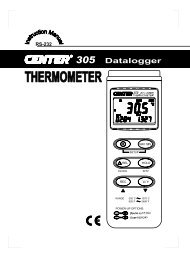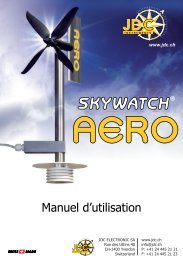Instruction manual
Instruction manual
Instruction manual
Create successful ePaper yourself
Turn your PDF publications into a flip-book with our unique Google optimized e-Paper software.
MADD<br />
sarl<br />
Technologies<br />
<strong>Instruction</strong> <strong>manual</strong><br />
EasyFlow<br />
MADDTechnologies sàrl – Rue des Uttins 40 – CH-1400 Yverdon-les-Bains – Switzerland<br />
Tel: +41 24 445 31 16 – Fax: +41 24 445 21 23 – Email: info@madd.ch – www.madd.ch
Contents<br />
Contents ..................................................................................................................... 3<br />
Warranty ..................................................................................................................... 3<br />
Gauging method by tracer dilution ................................................................................. 4<br />
Principle .................................................................................................................. 4<br />
Cooking salt as tracer .............................................................................................. 4<br />
Presentation of the device ............................................................................................ 5<br />
General information .................................................................................................. 5<br />
Technical characteristics .......................................................................................... 5<br />
Switch on the device ................................................................................................. 5<br />
Functions of the buttons........................................................................................... 6<br />
Main menu ............................................................................................................... 6<br />
Replacing the batteries ............................................................................................. 6<br />
Multimetre mode ...................................................................................................... 7<br />
Visualisation of the last measurement ........................................................................ 7<br />
Calibration of the probe ................................................................................................ 8<br />
Cleaning of the probe ................................................................................................ 8<br />
Preparing the calibration ........................................................................................... 8<br />
Calibration ............................................................................................................... 8<br />
Data acquisition on site .............................................................................................. 10<br />
Before starting the acquisition ................................................................................ 10<br />
Quantity of injected salt .......................................................................................... 10<br />
Measuring interval .................................................................................................. 10<br />
Beginning of the acquisition ..................................................................................... 10<br />
End of data acquisition ............................................................................................ 11<br />
Display of the results ............................................................................................. 11<br />
End of acquisition due to errors ............................................................................... 11<br />
Software EasyViewer .................................................................................................. 12<br />
Description ............................................................................................................ 12<br />
Installation ............................................................................................................. 12<br />
Data transfer to PC ............................................................................................... 13<br />
Practical tips ............................................................................................................. 14<br />
MADDTechnologies sàrl – Rue des Uttins 40 – CH-1400 Yverdon-les-Bains – Switzerland<br />
Tel: +41 24 445 31 16 – Fax: +41 24 445 21 23 – Email: info@madd.ch – www.madd.ch<br />
2
Contents<br />
At the delivery of a device EasyFlow, the package contains the following staff:<br />
A bag with shoulder strap<br />
Device EasyFlow with probe and 3 alkaline batteries 1,5V<br />
3 calibration doses of 20 millilitres<br />
A CD "EasyFlow" contening:<br />
o The software EasyViewer<br />
o The instruction <strong>manual</strong> of the device EasyFlow<br />
o An application note about the gauging method by tracer integration<br />
o A demo video of a gauging with the device SalinoMADD<br />
A serial cable for the communication between EasyFlow and a PC<br />
A plastified quick start guide<br />
The device is delivered ready to use and calibrated.<br />
Warranty<br />
The device is delivered with a factory warranty for one year from the date of the invoice. Repairs are made in our<br />
workshop; no further benefit can be taken into account without written confirmation of MADDTechnologies. It<br />
is understood that this warranty is available only if the device EasyFlow was used in conditions for which it was<br />
expected, as described below. Any other manipulation should be done at risk and peril of the user.<br />
MADDTechnologies sàrl – Rue des Uttins 40 – CH-1400 Yverdon-les-Bains – Switzerland<br />
Tel: +41 24 445 31 16 – Fax: +41 24 445 21 23 – Email: info@madd.ch – www.madd.ch<br />
3
Gauging method by tracer dilution<br />
The device EasyFlow uses the tracer dilution method to determine the stream flow of the measured<br />
watercourse.<br />
Principle<br />
The main principle of this method consists to inject into a watercourse a concentrated solution of tracer.<br />
Downstream, at a distance large enough from the injection point for a good mix with the river water, the tracer<br />
concentration is measured during the passage of the tracer could. This dilution is a function of flow rate,<br />
assumed constant along the section concerned during the measurement time.<br />
The following conditions are necessary for the application of the dilution method:<br />
The flow of the river should remain roughly constant during the measurement;<br />
The tracer must pass totally through the gauging sector;<br />
At the measuring point, the mixture should be such that at each point of the section of the river must<br />
spend the same amount of tracer.<br />
According to the above conditions, this method is especially adapted in case of low depths, very high speed or in<br />
presence of turbulences that does not guarantee a stable speed, like rivers or streams. As against, it is not<br />
suitable for measuring flow in concrete channels which does not permit the mixing of the water.<br />
Cooking salt as tracer<br />
The cooking salt, sodium chloride (NaCl), is an ideal tracer: it is very easy to find, cheap and has a high degree of<br />
dilution in water. Furthermore, it is not harmful to the fauna and flora at the concentrations used and it is few<br />
absorbed by vegetation and materials of the bed of the river. Finally, it is very easy to measure its concentration<br />
with a conductivity probe.<br />
In this case, the operator injects into the river a known mass of salt M diluted in a volume of water of the river.<br />
Downstream, is placed a conductivity probe that will measure the electrical conductivity of water throughout<br />
the duration T of passage of the cloud of salt. A linear relationship exists between the conductivity of water and<br />
dissolved salt concentration. The concentration curve can therefore be deduced in function of time C t. The flow<br />
Q is then obtained by integrating the concentration over time:<br />
Q : flow of the water course [l/s]<br />
M : mass of the injected tracer [mg]<br />
C t : water salinity at time t [mg/l]<br />
C 0 : basic water salinity [mg/l]<br />
T : duration of gauging [s]<br />
MADDTechnologies sàrl – Rue des Uttins 40 – CH-1400 Yverdon-les-Bains – Switzerland<br />
Tel: +41 24 445 31 16 – Fax: +41 24 445 21 23 – Email: info@madd.ch – www.madd.ch<br />
4
Presentation of the device<br />
General information<br />
The device EasyFlow is delivered in a very useful carrying bag with shoulder strap, so it can be taken away on the<br />
field in best conditions. It is recommended to replace the device and the probe in the bag after its use; this will<br />
guaranty its protection. Although it has been designed to withstand rough working conditions, it is a high<br />
precision instrument which should be protected from shocks. Used with a minimal of care your EasyFlow will be<br />
reliable and long lasting work tool.<br />
Technical characteristics<br />
Device<br />
Gauging range 0,1 l/s to 99'900 l/s<br />
Gauging accuracy < 5 % (with optimum mix of tracer)<br />
Gauging repeatability 1%<br />
Tracer type Cooking salt (NaCl)<br />
Tracer quantity 10 g to 100 kg of salt<br />
Tracer ideal mix Between 5 and 20 g of salt per l/s of estimated flow. (Ex : ~300 l/s -> 2 kg)<br />
Supply 3 x 1,5V alkaline batteries, AA, LR6 type<br />
Autonomy About 100 hours under normal conditions<br />
Communication Serial link RS-232<br />
Dimensions / weight Complete bag : 260 x 190 x 130 mm / 1240 g<br />
Device with probe : 230 x 150 x 80 mm / 620 g<br />
Waterproof IP65<br />
Salinity<br />
Measuring range 0 to 3200 mg/l<br />
Sensitivity 1 mg/l<br />
Precision < 1 %<br />
Temperature<br />
Measuring range 0 to +40 °C<br />
Precision 0,2 °C<br />
Switch on the device<br />
When pressing the ON/SELECT button the EasyFlow is switched on and this display<br />
(on the right) appears after 2 seconds. It contains the version of the device and<br />
actual batteries tension.<br />
If this tension is under 3.3V this message appears and the batteries should be<br />
replaced. Press ENTER to continue.<br />
If the tension is under 3V, this message is shown during 5 seconds, then the device<br />
shutdown. It is here necessary to change the batteries before working with the<br />
EasyFlow. (See previous chapter)<br />
MADDTechnologies sàrl – Rue des Uttins 40 – CH-1400 Yverdon-les-Bains – Switzerland<br />
Tel: +41 24 445 31 16 – Fax: +41 24 445 21 23 – Email: info@madd.ch – www.madd.ch<br />
5
Functions of the buttons<br />
The device EasyFlow possesses two buttons placed on the front panel:<br />
The button ON/SELECT permits to switch on the device and to change the selection in the menu.<br />
The button ENTER permits to enter into a menu or to go to the next step.<br />
Main menu<br />
2 seconds after the presentation of the version and the batteries tension, the main menu appears. It is the<br />
possible to select one of the seven menus by pressing the button SELECT. To enter into the selected menu,<br />
press on ENTER.<br />
Replacing the batteries<br />
Menu Multimetre. This menu permits to do instantaneous and continues<br />
measurements of the salinity in milligrams per litre and the temperature in °C.<br />
Menu Last measure. In this menu is presented the value of the last calculated<br />
and saved flow rate.<br />
Menu Acquisition. This menu permits to effectuate the gauging of a river, on the<br />
field.<br />
Menu Communication. This menu permits to transfer the data from the device to<br />
a PC via the serial cable.<br />
Menu Language. This menu permits to change the language of the display. Choose<br />
between French, German and English.<br />
Menu Calibration. In this menu it is possible to recalibrate the salinity probe to<br />
correct eventual drifts.<br />
Menu End. This menu permits to switch off the device EasyFlow after 1 second.<br />
The batteries are reachable inside the device. Unscrew the six screws at the bottom, open carefully the housing<br />
and open the batteries compartment. Replace the 3 old cells respecting the indicated polarity. Close the<br />
housing and tighten screws.<br />
New batteries deliver a voltage of 4.5 volts. This tension is displayed at the start of the device. When the<br />
tension goes down 3.3 volts, it is recommended to change the batteries and under 3V, the device is<br />
automatically shutdown after a warning message. The autonomy is about 100 hours in normal conditions of use<br />
with alkaline cells 1.5V type LR6, AA, UM3<br />
MADDTechnologies sàrl – Rue des Uttins 40 – CH-1400 Yverdon-les-Bains – Switzerland<br />
Tel: +41 24 445 31 16 – Fax: +41 24 445 21 23 – Email: info@madd.ch – www.madd.ch<br />
6
Multimetre mode<br />
This function permits to use the EasyFlow for punctual water quality measurements.<br />
From the main menu, choose with the button SELECT the mode Multimetre then press the button ENTER. At<br />
this moment the device measures continuously the salinity and the temperature. Press on SELECT to switch<br />
from salinity measurements to the temperature.<br />
To go back to the main menu, just press on ENTER. In this mode, without touching any button, the device will<br />
automatically shut down after 1 minute.<br />
Visualisation of the last measurement<br />
After a gauging, it is always possible to visualise the value of the last computed<br />
flow rate. Select Last measure in the main menu.<br />
The button ENTER permits to return to the main menu.<br />
MADDTechnologies sàrl – Rue des Uttins 40 – CH-1400 Yverdon-les-Bains – Switzerland<br />
Tel: +41 24 445 31 16 – Fax: +41 24 445 21 23 – Email: info@madd.ch – www.madd.ch<br />
7
Calibration of the probe<br />
Cleaning of the probe<br />
Ensure that the probe is clean before starting calibration. Clear the electrodes from calcareous deposits using<br />
a specific cleaning agent (Durgol, cleaning vinegar etc.). To do so, remove the protective cap covering the glass<br />
tube around the electrodes for easy access. Pour cleaning agent into a recipient up to the level necessary for<br />
complete immersion of the probe's glass part which should remain in the cleaning liquid for about 20 minutes.<br />
Rinse the probe thoroughly in order to clear off completely the cleaning liquid, let it dry and then place it into<br />
previously prepared half-litre of pure water.<br />
Preparing the calibration<br />
Following preparation is necessary before calibrating the probe for salinity gauging.<br />
Prepare very precisely 100 ml of demineralised water with a maximum conductivity of<br />
10 µS (or a resistivity of at least 100'000 this water in a cleaned 1 litre<br />
plastic measure. For maximum measurement accuracy, it is also possible to weight<br />
the water (100 grams of demineralised water). Place the probe of the EasyFlow into<br />
the water.<br />
Prior to the actual calibration the probe should have the waters temperature, which<br />
can be checked by setting the EasyFlow in Multimetre mode and ensuring that the<br />
temperature remains stable. Once all parameters meet the conditions laid down the<br />
actual calibration, taking only a few seconds, can be carried out<br />
Calibration<br />
From the main menu, choose Calibration then Calibration -> 3200 mg/l with help of<br />
the buttons SELECT and ENTER.<br />
The calibration of the salinity probe is done in 5 points: at 0 mg/l, 2200 mg/l, 1200 mg/l, 629 mg/l and 321 mg/l.<br />
Just follow the instructions that appear on the display<br />
1. Place the probe into 100 ml of demineralised water (see instructions on<br />
previous page, chapter 4.2). Be sure that the probe is well in water and press<br />
ENTER.<br />
2. Poor a calibration dose of 20 ml into pure water and use the probe to stir it well<br />
in order to get a homogenous mixture. At this moment the solution contains<br />
2200 mg of salt per litre of water. Press ENTER.<br />
3. The third point of the calibration is obtained by adding 100 ml of pure water to<br />
the solution. So the salinity reaches 1200 mg of salt per litre. Well stir and<br />
press ENTER when the solution is homogenous.<br />
4. Adding 200 ml of pure water to the solution to obtain the fourth point of the<br />
calibration. Now the salinity reaches 629mg of salt per litre. Well stir and press<br />
ENTER when the solution is homogenous.<br />
5. The calibration of the fifth and last point is done by adding 400 ml of pure water<br />
to the solution. The final salinity is at 321 mg/l. Stir well the solution and press<br />
ENTER when the solution is homogenous.<br />
6. The device will automatically calculate the precise values of the 5 calibration<br />
points. It will furthermore determine the non-linearity of the probe and compute<br />
the necessary corrections.<br />
MADDTechnologies sàrl – Rue des Uttins 40 – CH-1400 Yverdon-les-Bains – Switzerland<br />
Tel: +41 24 445 31 16 – Fax: +41 24 445 21 23 – Email: info@madd.ch – www.madd.ch<br />
8
At the end of the calibration, it is still possible to abandon the calibration<br />
procedure by pressing SELECT. If the calibration was done correctly, press<br />
ENTER to save the calibration parameters in non-volatile memory, so these<br />
values will be maintained during the replacement of the batteries.<br />
Remark: Be careful, the operator has only 5 minutes between each operation!<br />
MADDTechnologies sàrl – Rue des Uttins 40 – CH-1400 Yverdon-les-Bains – Switzerland<br />
Tel: +41 24 445 31 16 – Fax: +41 24 445 21 23 – Email: info@madd.ch – www.madd.ch<br />
9
Data acquisition on site<br />
Before starting the acquisition<br />
Before starting the acquisition, make sure that the probe has reached the water's temperature. The water<br />
salinity is directly dependent on the water temperature which is measured to correct the salinity and thus bring<br />
it to a standard 20° C. Just use the Multimetre mode to control the temperature stability.<br />
Quantity of injected salt<br />
For good results, this fine instrument requires a salinity increase of 10% or at least 15 mg per litre compared<br />
with the natural salt content of the water course. The acquisition of a complete measurement curve ensures<br />
good gauging. The quantity of salt to be injected should be known with precision since it is a factor for the water<br />
flow calculation.<br />
The quantity of injected salt should be well known because it will be used to<br />
calculate the flow rate. The recommended quantity of 5 to 20 g per litre/second of<br />
water flow depends on the distance to point of injection necessary for a good<br />
mixture. The longer the distance, the bigger the tracer dilution and then the<br />
smaller the increase in salinity in the gauging area.<br />
The EasyFlow allows salt injection from 10 g to 100 kg. The available salt quantities are the following:<br />
10, 20, 50, 100, 200 and 500 g, 1, 2, 5, 10, 20, 50 and 100 kg.<br />
Select the salt quantity with the button SELECT and confirm by pressing ENTER.<br />
Measuring interval<br />
After the salt quantity, the button SELECT permits to choose the interval between measurements.<br />
Choosing the interval between 1, 2, 4 or 8 seconds is directly related with the laps<br />
of time the salt cloud needs to completely pass by the gauging site. The total<br />
disposable memory for one gauging site being 1000 measurements the interval may<br />
allow data acquisition during ¼ hour, ½ hour, 1 hour or 2 hours.<br />
It is important to adapt the interval to the characteristics of the water course. Rapid and turbulent waters<br />
mixing and spreading the tracer rapidly allow rapid data acquisition and the injection of the tracer at shorter<br />
distance from the gauging area. In this case a shorter interval is chosen. If instead the volume of the water flow<br />
is high, the distance to the tracer injection point will be long and the time for the tracer cloud to pass by the<br />
gauging site will be longer. The interval will have to be longer as well. Experience in gauging with tracers will<br />
make the choice of sites and gauging parameters easier. Once the choice has been made, press ENTER.<br />
At this moment all necessary parameters for a good gauging has been introduced in the device and the<br />
acquisition can begin.<br />
Beginning of the acquisition<br />
After the start of the data acquisition, the EasyFlow begins the measurements<br />
according to the programmed interval. At each measurement, salinity and water<br />
temperature are displayed on screen. These measurements are checked to detect<br />
the arrival of the salt cloud.<br />
For correct operation, the device should do at least 30 measurements before the arrival of the salt cloud.<br />
In case where more than 100 measurements have been done before the arrival of the salt cloud and to prevent<br />
wasting memory space, the device will only conserve the last 100 measurements. So, the memory cannot be full<br />
before the arrival of the salt cloud.<br />
As soon as the salt cloud has been detected, the display shown here appears.<br />
Instead of the now useless temperature indication, the initial salinity "IS" is<br />
displayed. At the end of the acquisition procedure, the salinity should have reached<br />
again this initial value. On the second line is always displayed the actual salinity "S".<br />
MADDTechnologies sàrl – Rue des Uttins 40 – CH-1400 Yverdon-les-Bains – Switzerland<br />
Tel: +41 24 445 31 16 – Fax: +41 24 445 21 23 – Email: info@madd.ch – www.madd.ch<br />
10
End of data acquisition<br />
During the whole measuring procedure, the EasyFlow keeps trying to detect the<br />
end of the salt cloud. The operator will follow the evolution as well. When the water<br />
salinity comes back to its initial value, the display will normally say End of cloud.<br />
The operator will ensure that the salinity has dropped to its initial value. If so he<br />
can stop the procedure by pressing ENTER. The EasyFlow does not switch off automatically unless the memory<br />
is exhausted. At this moment or when pressing touch ENTER, the measurements are saved in memory and then<br />
begin the flow rate computing. For this last one all measurements until the pressure on the button ENTER will<br />
be used.<br />
Display of the results<br />
The procedure having run normally, the module having detected the beginning and<br />
the end of the salt cloud, it will now display the result as shown here at the right. If<br />
at the moment of the display shows End of cloud the measurement of salinity has<br />
reached its initial value, we may take it for granted that all the injected salt has<br />
passed though the gauging area.<br />
It may happen that the EasyFlow does not detect the end of the cloud despite favourable conditions and that<br />
the operator interrupts the procedure. The estimated value should in fact be quite correct since the beginning<br />
of the cloud had been detected correctly by the module and the end by the operator.<br />
To verify that the gauging was well done and to eventually correct the flow calculation it is recommended to<br />
transfer the data to the PC. (See next chapter)<br />
End of acquisition due to errors<br />
If the EasyFlow has not been in a position to acquire a sufficient amount of measurements or if an anomaly has<br />
been produced during the gauging, one of the following errors could appear.<br />
Causes: Insufficient amount of measurements (
Software EasyViewer<br />
Description<br />
The software EasyViewer permits the visualization of the gauging curve done with help of the device EasyFlow.<br />
The data are loaded from the device into the PC via the furnished serial cable and then presented as graph.<br />
The software also permits to:<br />
Save the data in EVW file.<br />
Modify the gauging parameters as the quantity of salt or the measurements interval.<br />
Recalculate the flow rate value by acting directly on the graph.<br />
Add information about the gauging<br />
Print the gauging curve<br />
Reload old data from EVW file<br />
Installation<br />
The installation of the software EasyViewer is launch from the delivered CD. This software needs at least<br />
Windows 2000 © and a serial port. If your PC doesn’t have a serial port, an USB-serial adapter can be used.<br />
Installation procedure:<br />
1. Introduce the CD in the drive.<br />
2. The following windows should appear. If not, launch the installation from D:\EasyViewer\Setup.exe.<br />
3. Select the installation folder and click Finish.<br />
MADDTechnologies sàrl – Rue des Uttins 40 – CH-1400 Yverdon-les-Bains – Switzerland<br />
Tel: +41 24 445 31 16 – Fax: +41 24 445 21 23 – Email: info@madd.ch – www.madd.ch<br />
12
Data transfer to PC<br />
The data transfer from the device EasyFlow to the PC is done with help of the serial cable furnished with the<br />
device.<br />
Procedure<br />
1. Connect the serial cable to a serial port of the PC and at the connector of the EasyFlow.<br />
2. Launch the application EasyViewer and verify that the configured serial port is the good one.<br />
3. Switch on the device EasyFlow, select the Communication menu with the<br />
button SELECT and press ENTER. The device is now waiting on a<br />
communication from the PC. It is always possible to quit this menu by<br />
pressing SELECT.<br />
4. In the software EasyViewer, select “Load the data from EasyFlow" and click<br />
Ok. The progression of the transfer is showed on the screen of the<br />
EasyFlow. The transfer normally takes only few seconds.<br />
5. Once the transfer terminated, press ENTER to return to the main menu. In case of error, verify the<br />
connection and the serial settings and try again.<br />
If all was done correctly, a window with a graph appears on the PC. For any further question about the use of<br />
the software EasyViewer, please consult the online help of the software<br />
MADDTechnologies sàrl – Rue des Uttins 40 – CH-1400 Yverdon-les-Bains – Switzerland<br />
Tel: +41 24 445 31 16 – Fax: +41 24 445 21 23 – Email: info@madd.ch – www.madd.ch<br />
13
Practical tips<br />
Upon arrival at the measurement site, place immediately the probe into the water. It will then reach fast<br />
the water temperature.<br />
Try to position the probe in a place where the water course is not too turbulent. Always avoid the<br />
phenomenon of cavitation around the probe. It can perturb the measurements and cause air bubbles<br />
between the probe's electrodes.<br />
Before starting an acquisition, verify that the probe is at the waters temperature.<br />
Don’t forget that the EasyFlow must record at least 30 measurements prior to the arrival of the salt<br />
cloud. The time needed for these measurements is proportional to the gauging intervals as shown below:<br />
INTERVAL RECORDING BEFORE CLOUD ARRIVES<br />
1 second 30 seconds<br />
2 seconds 1 minute<br />
4 seconds 2 minutes<br />
8 seconds 4 minutes<br />
It is preferable to dilute the salt in water taken from the river to be gauged and then inject the total mixed<br />
solution at once into the water course (max. 300 g of salt per litre). Avoid not yet dissolved salt to sink to<br />
the bottom of the riverbed.<br />
The most important point for successful gauging is in fact the good dissolution and mixture of the salt in<br />
the water course. Some turbulence caused by a few stones or tiny waterfalls favours the mixing process.<br />
In a straight and flat riverbed or a canal placing some stones can help the mix.<br />
Small side streams of the water course and basins may slow down part of the current which does not<br />
favour the mixing process.<br />
A higher speed of the current is a positive factor for the mixing process and a rapid passage of the salt<br />
cloud favours the measuring since the threshold of natural salinity varies very little.<br />
Gauging in tunnels, straight canals with a current speed of 1 meter/second gives good results even at long<br />
distances (e.g. more than 3000 m) from point of salt injection.<br />
MADDTechnologies sàrl – Rue des Uttins 40 – CH-1400 Yverdon-les-Bains – Switzerland<br />
Tel: +41 24 445 31 16 – Fax: +41 24 445 21 23 – Email: info@madd.ch – www.madd.ch<br />
14




